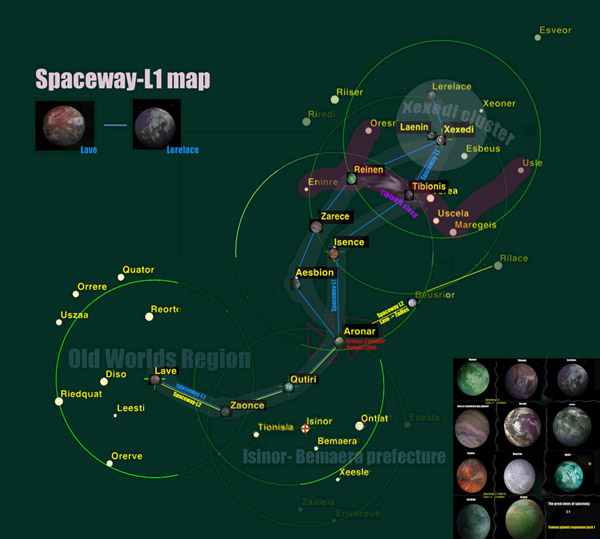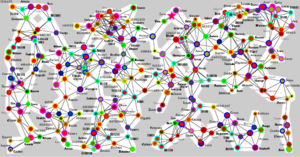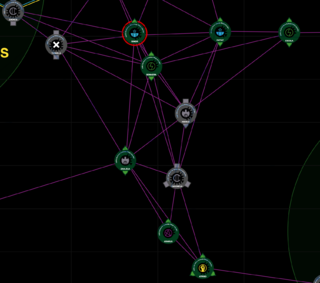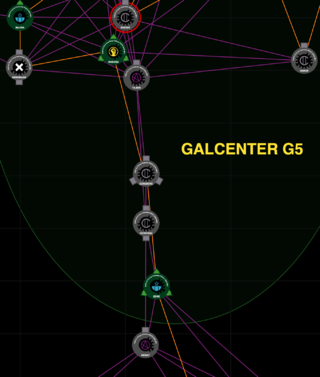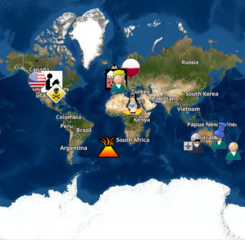Geography
Contents
Limits of the game-code
Whilst Oolite was originally just a rewrite of Classic Elite for the AppleMac, our first lead developer, Aegidian, starting opening out parts of the code for modifying. This process has continued since 2003 with more and more of the game being changeable. This area is one of those which are still relatively restricted by the game code.
Limits: galactic
The coding currently restricts Oolite to eight two-dimensional galaxies with 256 systems in each.
There are several ways in which you can get around this which include:
- See cim's Song of the Labyrinth for oxp's which create a new discovery game set in one of two new galaxies.
- See Galaxy Seeds for detail on how to change the galaxies yourself!
- See More/larger galaxies (2014) for tips on increasing the sizes of your galaxies as well as the number
Limits: intra-galactic
The vanilla game code provides for just one star with one close-by planet. No moons. No rings. No solar flares. This is, as you probably realise, easily alterable by the OXPs (see Guide to Ambience OXPs for more detail). Thus, OXP's have created rings, solar flares, a pulsar, etc. They have changed the star types, distances, the look of the nebulae, etc.
At the time of writing (2021) Oolite lacks the following:
- No black holes.
- No binary systems.
- No quasars.
Double star systems
While the game code does not allow for true binary systems, there are some so-called "double star systems" (see links below):
- Galaxy 3: Quzaarar & Riusbequ
- Galaxy 4: Riusbequ & Quzaarar
- Galaxy 5: Tezabi & Divees
- Galaxy 5: Zaenza & Lazaso; Tetiri & Orlaed
- Galaxy 8: Esusale & Cecees
Limits: Nomenclature
The original game code working from the Random number generator created names from a string of letters. All to do with the Fibonacci sequence! This means that there is a little repetition - Cetiisqu in both galaxies 1 & 5, Xeer (G1 and G7), Laquused (G4 and G5) and Inzaan (both in galaxy 8!), etc.
Effects of 7ly hyperdrive limit
The 7 lightyear jump limit limits which systems can be reached - for example, The Great Rift in Galaxy 7. There, some 30 systems are stranded in an "island" more than 7ly from the rest of the systems (but see An Ideal Victim...).
But there are also effects on local geography too. As well as islands, peninsulae are created. The effects of this can clearly be seen if one tampers with this limit - see Redspear's Hyperdrives OXP.
Cim, Oolites 3rd Lead Developer on the importance of Geography
Takes off dev hat, puts on player/OXP writer hat
Well, with 2048 systems in the original 8, it's not as if the average player - or even a committed member of the Explorer's Club - is going to visit them all in a hurry. So an extra 2048 which are more of the same (but with fewer content or mission OXPs available) doesn't immediately sound appealing. What they need is interesting stories that couldn't be told in the original 8.
Geography makes the difference
There really isn't a lot of difference in direct gameplay terms between Sector1/Ensoreus (Gal 1, Rich Ind Corporate, TL 12) and Sector5/Edxebere (Gal 5, Rich Ind Corporate, TL 12). But while Ensoreus is the technological and industrial anchor of a small cluster of mostly-agricultural stars, Edxebere is a gateway system - along with its sister world of Gediesqu - between the dense mostly-stable cluster of Galcentre G5, and the dangerous and bottleneck-filled trail that leads from the Siege Worlds down to the trader's graveyard of Bizaar.
Ensoreus is a local trading hub of some importance, well positioned to fend off competition from Zaonce and Tionisla on the edges of its cluster - and it exploits this to keep the nearby Agricultural worlds mostly pretty poor and dependent on it.
Edxebere - with Inbior, Bisoaton, and a range of other high tech worlds just two jumps to its north - is mainly a place people go through on their way to somewhere more interesting, or for emergency repairs after a nasty experience in Anisat when traversing the trail eastward.
Geography creates the stories
The stories that get told about each place are very different, despite their apparent similarity. There are three types of stories to tell ... not without overlap, of course:
1) The unfolding personal narrative as you play the game
2) Stories told through the medium of fiction
3) Stories told through a mission OXP.
There are entire regions of the Eight - in some cases getting on for entire galaxies - which don't yet have their stories told to a wide audience (indeed, once you get out of Chart 1, the stories get much sparser). If you start with the topology, and work out of the story, there are hundreds of interesting OXPs and/or novellas yet to be written, just from the existing eight charts.
Of course, sometimes you want to start with the story, and then find a place in the charts to set it. The charts are very diverse already, so there's usually space for it. So - a 9th chart is only useful in my opinion if it lets a story be told that someone wants to tell but can't in the original 8 because there's nowhere it makes sense to set it. Find that story - and a chart that allows it - and there's your justification.
The 7LY jump limit
Incidentally, this is why the 7LY jump limit is for me the key thing that makes Oolite what it is. With the jump limit increased by a mere 0.2LY, for instance, a jump from Bexe to Zaenza becomes possible, and the Steel Halo in Gal 5 goes from being an extremely interesting branch with one story already set there - and at least one other very obvious story no-one's yet published - to being a relatively dull cluster of industrial and semi-industrial worlds.
Editor's note: The French Annalistes school was convinced that geography created history, and thus the history of an island would be different from that of a mountainous peninsula, and again, from that of a desert country.
In-game geographical differences
Galactic Differences
I find the eight galaxies have a very different feel to them.
|
| (Cim) |
- Oolite planet list/Galaxy 1
 Academies of Galaxy 1
Academies of Galaxy 1  There a lot of OXPs adding colour to Galaxy 1: Lave OXP, Monument, the Tionisla oxp's, Tianve OXP, Riredi OXP, Taranis, Diso OXP etc.
There a lot of OXPs adding colour to Galaxy 1: Lave OXP, Monument, the Tionisla oxp's, Tianve OXP, Riredi OXP, Taranis, Diso OXP etc. - Oolite planet list/Galaxy 2
 Academies of Galaxy 2
Academies of Galaxy 2  Ionics adds special ships and a war!
Ionics adds special ships and a war! - Oolite planet list/Galaxy 3
 Academies of Galaxy 3
Academies of Galaxy 3  Aquatics OXP introduces special ships, mission and a station to this galaxy.
Aquatics OXP introduces special ships, mission and a station to this galaxy. - Oolite planet list/Galaxy 4
 Academies of Galaxy 4
Academies of Galaxy 4  The missions set in this galaxy introduce a number of very different scenarios: Deposed, Love Cats & Trident Down.
The missions set in this galaxy introduce a number of very different scenarios: Deposed, Love Cats & Trident Down. - Oolite planet list/Galaxy 5
 Academies of Galaxy 5
Academies of Galaxy 5  Resistance Commander gives you a role in an invasion. Coyote's Run introduces a number of galaxy 5 specialities.
Resistance Commander gives you a role in an invasion. Coyote's Run introduces a number of galaxy 5 specialities. - Oolite planet list/Galaxy 6
 Academies of Galaxy 6
Academies of Galaxy 6  Vortex is broken ... sorry!
Vortex is broken ... sorry! - Oolite planet list/Galaxy 7
 Academies of Galaxy 7
Academies of Galaxy 7  The Assassins Guild OXP introduces special ships, missions & planet descriptions to this galaxy.
The Assassins Guild OXP introduces special ships, missions & planet descriptions to this galaxy. - Oolite planet list/Galaxy 8
 Academies of Galaxy 8
Academies of Galaxy 8  Iron Raven introduces new ships
Iron Raven introduces new ships
- There are also the Shipsets - you can choose different shipsets for the different galaxies to give a very different look to each of them. Ditto with Orbital stations (more awkward, but doable).
- Famous Planets adds colour to many of the systems of Galaxies 1, 2 & 8 (if you look at your F7 page!).
Regional differences
Regions are put on the in-game maps by Explorers' Club OXP & by GalCop Galactic Registry. There are several varieties of these regions.
- Iron Stars cluster in Galaxy 1 (Economic) - the markets are very similar (more difficult to make a profit until you leave the region!)
- Pulsar Worlds (supposedly visual - one should be able to see the pulsar!)
- Devil's Triangle (political) - pirate infested - and the game code spills this out to the general locale in Oolite v.1.80 and later
OXPs making geography relevant
- Darkside Moonshine Distillery creates an regional increase in price of the whisky as distance from the distilleries in the Tortuga expanse increases
- New Cargoes creates a market in over 100 specific versions of regular commodities - eg Vacuum Karate training videos (luxury) or Earthquake Predictors (computers). These are only produced by a handful of systems - and will only sell at full price to another handful... You need to know your geography for this one!
- Diplomancy can create no-go areas where one cannot buy visas for travel to systems (ie visiting the Communists in Sector1/Onlema & Sector1/Soorbi when they are at war with their neighbours). You can visit the systems, but not dock at the official system's stations!
- Smugglers creates difficulties in trade routes when commodities suddenly become illegal for a particular system!
- Weapon Laws creates difficulties in buying combat equipment - not only do you need the right TL, but you need the right political system too!
Trade Routes
Put on the map by GNN's news broadcasts, & by GalCop Galactic Registry. It is uncertain if there is any real logic behind these routes. CaptSolo has quite a different network of trade routes on his maps.
- In-game differences made by Fuel Station OXP: placing fuel stations in the more stable systems on SpaceWay L1 in galaxy 1
- Liners used to part of a suite of Povray Planets OXPs and ran the liners along the trade routes. The suite included planet textures, planet descriptions (now the Famous Planets OXP), liners & specific music for various systems!
Links
- Maps
- The Eight
- Powers and Organisations has a listing of organisations specific to each galaxy.
- Galaxy Seeds
- History
- Distance (Oolite)
- Light Mach
BBB threads
- Cool OXPs for celestial objects (2021)
- Terraforming (2008)
- Double Star Systems (2010)
- More/larger galaxies (2013-6) There is a summary towards the end of what seems to be the essential bits.
- Box account for the above (2014)
- 3D galaxy prototype (2011) Ahruman's thoughts on implementing a 3D galaxy on the F6 pages
OXPs
- Hyperdrives - different strength hyperdrives change the galactic geography
- Explorers' Club OXP - records where you have been
- GalCop Galactic Registry - essential database
- Song of the Labyrinth - experiment with related games in two new galaxies
Your Real-Life Geography
Some instructions on how to pin your marker on the new Oolite Map:
- Go to http://www.scribblemaps.com/maps/view/Oolite_Map/3US4ObF9uH
- Click on "Create A Map" on the upper-right corner of the page
- Click "Menu" from the toolbar and select Load/Import from the options pop-up window
- The Map Id is 3US4ObF9uH (the last part of the URL given by Selezen), leave the "Load" radio button checked and click the "Load Map" button
Now the easy part follows:
- Select the "Move the Map" toolbar icon and Pan/Zoom to the location you want to pin for yourself
- Select the "Place a marker" toolbar icon and select the marker icon you like from the next pop-up window
- Click on the map to pin your marker and fill in a description for the marker in the pop-up window. Put your call sign in the title.
- Click "Menu" from the toolbar and select Save Map
- Add the Oolite08 password, given by Selezen, and click the "Save Map" button[/list]
Done!
Reference: Ooliteers Planet - An Interactive Pinmap (2012+)
